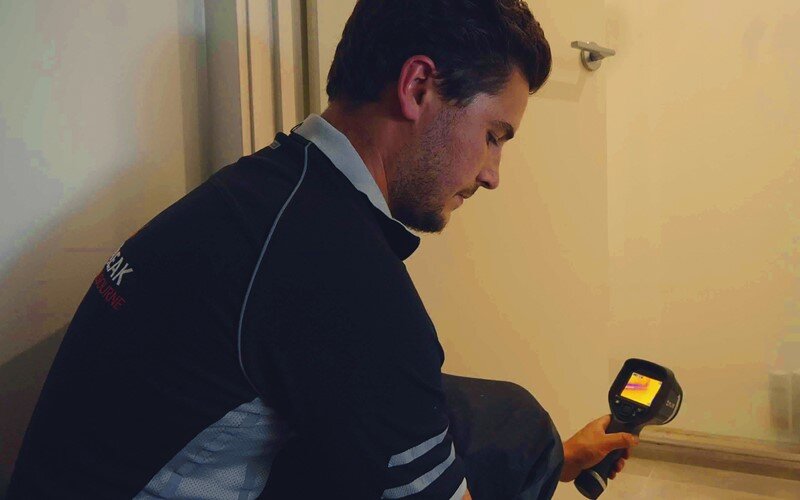Guide To Water Leak Discovery In The House
Guide To Water Leak Discovery In The House
Blog Article
What're your ideas with regards to Detecting hidden plumbing leaks?

Early discovery of dripping water lines can alleviate a prospective calamity. Some tiny water leakages may not be noticeable.
1. Take A Look At the Water Meter
Every home has a water meter. Checking it is a surefire manner in which helps you uncover leaks. For starters, turn off all the water resources. Make certain no person will purge, utilize the faucet, shower, run the washing equipment or dishwasher. From there, most likely to the meter and also watch if it will transform. Since nobody is utilizing it, there need to be no motions. That indicates a fast-moving leak if it relocates. Likewise, if you find no changes, wait a hr or two and inspect back once more. This suggests you may have a sluggish leakage that can also be underground.
2. Examine Water Intake
If you find unexpected modifications, despite your intake being the same, it means that you have leaks in your plumbing system. An abrupt spike in your bill shows a fast-moving leak.
A consistent boost every month, even with the very same routines, shows you have a sluggish leakage that's also slowly rising. Call a plumber to completely check your residential property, particularly if you feel a cozy location on your floor with piping underneath.
3. Do a Food Coloring Test
When it concerns water usage, 30% comes from commodes. Test to see if they are running appropriately. Decrease specks of food color in the container as well as wait 10 mins. If the shade in some way infiltrates your bowl throughout that time without flushing, there's a leak between the storage tank and also bowl.
4. Asses Exterior Lines
Don't fail to remember to examine your exterior water lines also. Should water seep out of the connection, you have a loose rubber gasket. One small leakage can lose tons of water and spike your water bill.
5. Analyze the situation and examine
Property owners must make it a routine to inspect under the sink counters as well as even inside cabinets for any bad odor or mold and mildew development. These two red flags indicate a leak so prompt focus is called for. Doing regular assessments, also bi-annually, can save you from a major trouble.
If you know your home is currently old, maintain a watchful eye on your heaters, tubes, pipelines and so on. Check for stainings and also damaging as a lot of pipes and devices have a life span. They will additionally normally weaken as a result of tear as well as wear. Do not wait for it to intensify if you suspect dripping water lines in your plumbing system. Call a professional plumber right away so you do not wind up with a horrible mess in your home.
Early detection of dripping water lines can reduce a possible disaster. Some little water leaks may not be noticeable. Checking it is a guaranteed way that assists you uncover leaks. One small leakage can waste heaps of water and surge your water costs.
If you suspect leaking water lines in your plumbing system, do not wait for it to rise.
WARNING SIGNS OF WATER LEAKAGE BEHIND THE WALL
PERSISTENT MUSTY ODORS
As water slowly drips from a leaky pipe inside the wall, flooring and sheetrock stay damp and develop an odor similar to wet cardboard. It generates a musty smell that can help you find hidden leaks.
MOLD IN UNUSUAL AREAS
Mold usually grows in wet areas like kitchens, baths and laundry rooms. If you spot the stuff on walls or baseboards in other rooms of the house, it’s a good indicator of undetected water leaks.
STAINS THAT GROW
When mold thrives around a leaky pipe, it sometimes takes hold on the inside surface of the affected wall. A growing stain on otherwise clean sheetrock is often your sign of a hidden plumbing problem.
PEELING OR BUBBLING WALLPAPER / PAINT
This clue is easy to miss in rooms that don’t get much use. When you see wallpaper separating along seams or paint bubbling or flaking off the wall, blame sheetrock that stays wet because of an undetected leak.
BUCKLED CEILINGS AND STAINED FLOORS
If ceilings or floors in bathrooms, kitchens or laundry areas develop structural problems, don’t rule out constant damp inside the walls. Wet sheetrock can affect adjacent framing, flooring and ceilings.
https://www.servicemasterbyzaba.com/blog/how-to-detect-water-leakage-in-walls/

As a keen person who reads on Detecting hidden plumbing leaks, I imagined sharing that blog post was a smart idea. Sharing is nice. Helping people is fun. I love reading our article about Hacks to detect leaks.
Report this page